ISSN ONLINE(2278-8875) PRINT (2320-3765)
ISSN ONLINE(2278-8875) PRINT (2320-3765)
Prof. D. U. Adokar1, Priti J. Rajput2
|
| Related article at Pubmed, Scholar Google |
Visit for more related articles at International Journal of Advanced Research in Electrical, Electronics and Instrumentation Engineering
The measurement and control applications for wind tunnel testing typically include the wind speed measurement and control, pressure profile measurement and model balancing with respect to the wind in the tunnel. These measurement and control applications are difficult as well as time consuming hence needs to be automated. This paper presents the implementation aspects of a reliable and automated wind tunnel instrumentation system using LabVIEW and performance analysis using MATLAB. The automation is done by controlling the tunnel wind speed control, model balancing, auto switching of the wind tunnel at critical temperature.
Keywords |
| 4G technology, Internet protocol, OFDM |
INTRODUCTION |
| This paper discusses the challenge of evolving the core network of today’s 2G and 3G networks to enable the unprecedented growth in voice and data expected with the migration to 4G wireless networks. The introduction of packet core infrastructure into digital wireless networks offers both challenges and opportunities for wireless service providers and its users. |
| Despite the economic situation and recent world events, the basic drivers of growth in mobile computing are as strong as ever. In fact, telecommuting and decentralized workforces are options many companies are looking at increasingly as they reevaluate their physical security vulnerabilities and develop risk management plans. Mobile devices have become significantly more powerful, and in many cases smaller and lighter versions are available. For handheld, the industry is rapidly moving towards color screens as the new standard -- though lower price and longer battery life keep monochrome units selling too. Storage and processor speeds have advanced as expected. While 3G haven’t quite arrived, designers are already thinking about 4G technologies. |
| Cellular service providers in India are slowly beginning to deploy third-generation (3G) cellular services. As access technology increases, voice, video, multimedia, and broadband data services are becoming integrated into the same network. The hope once envisioned for 3G as a true broadband service has all but dwindled away. It is apparent that 3G systems, while maintaining the possible 2-Mbps data rate in the standard, will realistically achieve 384-kbps rates. To achieve the goals of true broadband cellular service, the systems have to make the leap to a fourth-generation (4G) network. This is not merely a numbers game. 4G is intended to provide high speed, high capacity, low cost per bit, IP based services. The goal is to have data rates up to 20 Mbps, even when used in such scenarios as a vehicle traveling 200 kilometers per hour. |
| New design techniques, however, are needed to make this happen, in terms of achieving 4G performance at a desired target of one-tenth the cost of 3G. That’s the goal of 4G. In short, Fourth Generation (4G) mobile devices and services will transform wireless communications into on-line, real-time connectivity. 4G wireless technologies will allow an individual to have immediate access to location-specific services that offer information on demand at an amazingly high speed and low cost. Welcome to the world of amazing realities of an amazingly high-speed data communication and mobile technology at a very low cost. That’s 4G. |
LITERATURE SURVEY |
| The main purpose of bandwidth utilization efficiency is to provide services so that users can get higher data rates and wider coverage. However there is no single network that can provide this kind of services [6] 4G network is expected to integrate LAS-CDMA,OFDM, MC-CDMA, UWB and Network-LMDS so that higher data rates and wider coverage can be achieved [7]. In this integration, the users will be served by either one of those networks. As a result, an important problem occurred in which in these overlapping areas most of the network resources is not fully utilized since only one of those networks serve the users. |
| The bandwidth utilization efficiency is so important for operators, because the wireless communication cost and their profit are based on the network resources [8]. Thus, how to get the highest benefit from the available network resources is a key issue in the wireless communication networks. In the research, we focus on the two bandwidth integration of WLAN and CDMA2000 networks to efficiently utilize the two network resources. This chapter reviews the relevant literature to explain the existing researches. The flow of the relevant literature is presented, which focuses on the evolution of wireless communication networks and bandwidth utilization efficiently for 4G. We have divided this chapter into eight sections. In the first section, we give a general introduction. Section two discusses the developed evolution of wireless mobile communication networks. Section three highlights the fourth generation wireless mobile to Internet networks. WLAN protocol and frame will be presented in section four and the PPPoE protocol in section five. In section six, we present the relevant literature on bandwidth utilization. The related researches will then be presented in section seven before we give the conclusions in section eight. |
WIRELESS EVOLUTION |
A] First generation |
| The First Generation of wireless mobile communications was based on analog signaling. Analog systems, implemented in North America, were known as Analog Mobile Phone Systems (AMPS), while systems implemented in Europe and the rest of the world was typically identified as a variation of Total Access Communication Systems (TACS). Analog systems were primarily based on circuit-switched technology and designed for voice, not data. |
| In India First Generation mobile service were initially launched in 1995 in which only voice service were available. The service cost factor was also very high. |
B] Second Generation (2G) |
| The second generation of digital mobile phones appeared about ten years later to First Generation mobile phones, along with the first digital mobile networks. During the second generation, the mobile telecommunications industry experienced exponential growth both in terms of subscribers as well as new types of value-added services. Mobile phones are rapidly becoming the preferred means of personal communication, creating the world's largest consumer electronics industry. This way the telecommunication industry experienced for the first time the growth and profits of mobile telecommunication with advancement of technology. This prompted them to built more powerful communication means. |
| The second generation (2G) of the wireless mobile network was based on low-band digital data signaling. The most popular 2G wireless technology is known as Global Systems for Mobile Communications (GSM). GSM systems, first implemented in 1991, are now operating in about 140 countries and territories around the world. An estimated 248 plus million users now operate over GSM systems. GSM technology is a combination of Frequency Division Multiple Access (FDMA) and Time Division Multiple Access (TDMA). The first GSM systems used a 25MHz frequency spectrum in the 900MHz band. FDMA is used to divide the available 25MHz of bandwidth into 124 carrier frequencies of 200kHz each. Each frequency is then divided using a TDMA scheme into eight timeslots. The use of separate timeslots for transmission and reception simplifies the electronics in the mobile units. Today, GSM systems operate in the 900MHz and 1.8 GHz bands throughout the world with the exception of the Americas where they operate in the 1.9 GHz band. |
| In addition to GSM, a similar technology, called Personal Digital Communications (PDC), using TDMA-based technology, emerged in Japan. Since then, several other TDMA-based systems have been deployed worldwide and serve an estimated 89 million people worldwide. While GSM technology was developed in Europe, Code Division Multiple Access (CDMA) technology was developed in North America. CDMA uses spread spectrum technology to break up speech into small, digitized segments and encodes them to identify each call. CDMA systems have been implemented worldwide in about 30 countries and serve an estimated 44 million subscribers. |
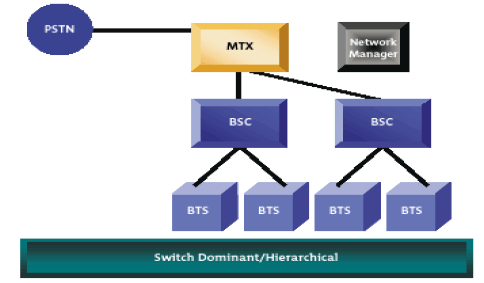 |
| While GSM and other TDMA-based systems have become the dominant 2G wireless technologies, CDMA technology is recognized as providing clearer voice quality with less background noise, fewer dropped calls, enhanced security, greater reliability and greater network capacity. |
| The Second Generation (2G) wireless networks mentioned above are also mostly based on circuit-switched technology. 2G wireless networks are digital and expand the range of applications to more advanced voice services, such as Called Line Identification. 2G wireless technology can handle some data capabilities such as fax and short message service at the data rate of up to 9.6 kbps, but it is not suitable for web browsing and multimedia applications. |
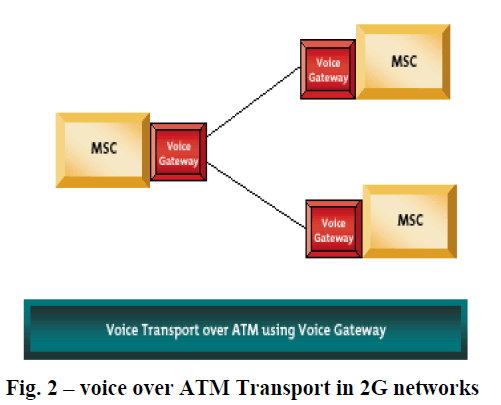 |
| What improvements were needed? Fundamentally, wireless users wanted even more from their mobile sets: |
| Email and fast internet access |
| Synchronization of mobile personal management tools with popular personal management software such as Microsoft Outlook, Lotus Organizer or Symantec ACT! |
| Location-based services such as navigation and mobile yellow pages |
| Robust "buddy" features such as messaging |
| Video |
| Wireless purchasing |
| Global roaming, etc |
| To meet these demands, network operators and wireless equipment manufacturers alike were turning toward a third generation (3G) of wireless systems that deliver higher data rates based on packet transmission and new modulation formats. But the path toward 3G, though evolving, was far from clear. In fact, there are many parallel paths, and at least one, probably two, generations of transitional technologies. A first step in realizing the benefits associated with a packet core is to under-stand that voice gateways can play a crucial role. Packet media gateways are part of a new generation of switching technology that enables the integration of wireless (2G/2.5G/3G), fixed IP, PSTN and IN-based services. There are three key elements to this next-generation switching architecture: core IP/ATM switches/routers, media gateways in which wireless is just another access method, and call servers and application platforms. |
C] Second Generation (2G+) Wireless Networks |
| As stated in a previous section, the virtual explosion of Internet usage has had a tremendous impact on the demand for advanced wireless data communication services. However, the effective data rate of 2G circuit-switched wireless systems is relatively slow -- too slow for today's Internet. As a result, GSM, PDC and other TDMA-based mobile system providers and carriers developed 2G+ technology which was packet-based and increases the data communication speeds to as high as 384kbps. |
| These 2G+ systems are based on the following technologies: High Speed Circuit-Switched Data (HSCSD), General Packet Radio Service (GPRS) and Enhanced Data Rates for Global Evolution (EDGE) technologies. HSCSD is one step towards 3G wideband mobile data networks. This circuit-switched technology improves the data rates up to 57.6kbps by introducing 14.4 kbps data coding and by aggregating 4 radio channels timeslots of 14.4 kbps. |
| To meet the needs of today’s subscribers, wireless service providers are in the process of upgrading their 2G networks to 2.5G networks. These 2.5G networks continue to use the 2G architecture to deliver voice and circuit-switched data applications while adding a packet data overlay to support additional packet data services. Upgrading a 2G wireless infrastructure to support 2.5G enables subscribers on this network to attain data rates up to 170 kbps, a substantial increase over 2G data rates. Choosing a multi-service core network solution that efficiently handles multiple traffic types (e.g., packet data, voice, etc.) not only gives the operator the capability of providing new services with increased data rates, but also saves on TDM voice expenditures as previously outlined. |
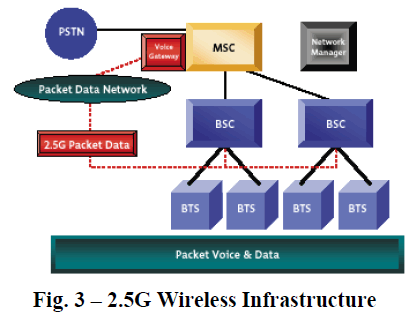 |
| The following table below summarizes the most influential standards that are expected to take the industry through the 2.5G transitions. Note that the 2G infrastructure will remain in place and operational, even as it evolves through 2.5G. Thus, the existing 2G standards are included in this list. |
D] MOVING TOWARDS 3G |
| The "path to 3G" (see Figure 4) begins with several parallel 2G paths depicting the currently deployed technologies. It has become increasingly apparent that subscribers will not wait until the final 3G technologies have been deployed. For this reason, many of the 2.5G standards were been developed for deployment in the interim. Surprisingly, many of these, notably GPRS, EDGE, and IS136B/HS, may offer sufficient capabilities to satisfy end user customers for years to come. It seems likely that, short term, significantly more rather than fewer standards will emerge and be used concurrently, often running on adjacent or common carrier frequencies. The 2.5G transition period promises to be even more complex than today's 2G market. |
| As we look at the "road map" (Figure 4) of the transition from 2G to 3G, it's important to note that the journey begins with several parallel 2G paths (GSM, CDMA, etc.), which split into even more paths before converging, ideally, on a single 3G standard. HSCSD (High-speed Circuit-Switched Data) and GPRS (General Packet Radio Service) will share the market with emerging variants of IS-136 and IS-95. The 2.5G transition period promises to be even more complex than today's 2G market. |
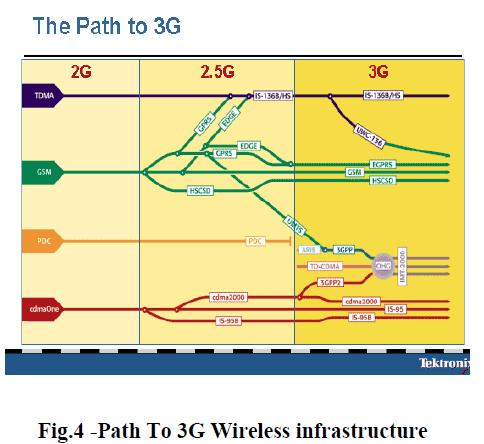 |
| As Figure 4 implies, equipment manufacturers and network operators will continue to need test solutions for multiple standards during the 2.5G period, even more so than they have in the past. Given that many different standards will exist, equipment manufacturers must be able to adopt flexible design and manufacturing processes to meet changing demands. For many equipment manufacturers it may be necessary to design and manufacture GSM, TDMA, CDMA One, HSCSD, GPRS, EDGE, EGPRS, IS-136B/HS, and IS-95B phones and network elements concurrently, often building them on the same manufacturing lines. |
E] Third Generation (3G) Wireless Networks |
| 3G wireless technology represents the convergence of various 2G wireless telecommunications systems into a single global system that includes both terrestrial and satellite components. One of the most important aspects of 3G wireless technology i s its ability to unify existing cellular standards, such as CDMA, GSM, and TDMA, under one umbrella. The following three air interface modes accomplish this result: wideband CDMA, CDMA2000 and the Universal Wireless Communication (UWC- 136) interfaces. Wideband CDMA (W-CDMA) is compatible with the current 2G GSM networks prevalent in Europe and parts of Asia. W-CDMA will require bandwidth of between 5Mhz and 10 MHz, making it a suitable platform for higher capacity applications. It can be overlaid onto existing GSM, TDMA (IS-36) and IS95 networks. Subscribers are likely to access 3G wireless services initially via dual band terminal devices. W-CDMA networks will be used for high-capacity applications and 2G digital wireless systems will be used for voice calls. |
| The second radio interface is CDMA 2000, which is backward compatible with the second generation CDMA IS-95 standard predominantly used in US. |
| The third radio interface, Universal Wireless Communications – UWC-136, also called IS-136HS, was proposed by the TIA and designed to comply with ANSI-136, the North American TDMA standard. 3G wireless networks consist of a Radio Access Network (RAN) and a core network. The core network consists of a packet-switched domain, which includes 3G SGSNs and GGSNs, which provide the same functionality that they provide in a GPRS system, and a circuit-switched domain, which includes 3G MSC for switching of voice calls. Charging for services and access is done through the Charging Gateway Function (CGF), which is also part of the core network. RAN functionality is independent from the core network functionality. The access network provides a core network technology independent access for mobile terminals to different types of core networks and network services. Either core network domain can access any appropriate RAN service; e.g. it should be possible to access a âÃâ¬Ãâ¢speechâÃâ¬Ãâ radio access bearer from the packet-switched domain. |
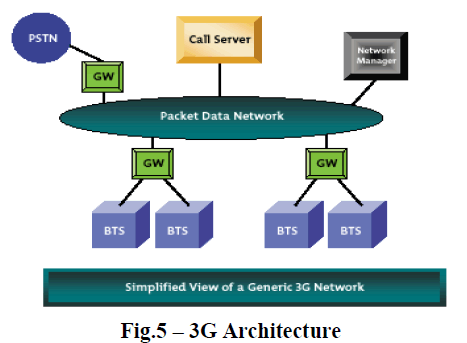 |
| 3G: what's new? Is 3G is designed to deliver |
| A wide range of market-focused applications |
| Long-term market-driven creativity, an innovative value chain and real user benefits, driving genuine market demand |
| Advanced, lightweight, easy-to-use terminals with intuitive interfaces · Instant, real-time multimedia communications |
| Global mobility and roaming |
| A wide range of vendors and operators, offering choice, competition and affordability |
| High-speed e-mail and Internet access |
F] The Speed |
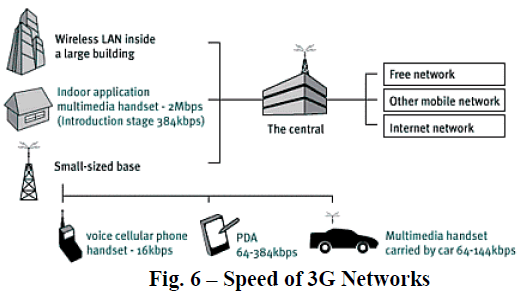 |
| 3G enabled users to transmit voice, data, and even moving images. In order to realize these services, 3G improves the data transmission speed up to 144Kbps in a high-speed moving environment, 384Kbps in a low-speed moving environment, and 2Mbps in a stationary environment. 3G provides services like Internet connection, transmission of large-scale data and moving contents photographed by digital cameras and videos, and software downloading. |
| At present, maximum data transmission speed is 64Kbps offered in 3G services, and it was expected that by toward early 2001, 384Kbps would be possible. At the early stage of 3G services, a 144Kbps-transmission speed is expected. By around 2005 when 3G is in general use; a maximum speed of 2Mbps will be possible. |
F] What are the standards saying? |
| It is important to understand what people mean when they talk about an all-IP network. For instance, does it play at the transport, service or application level? Clearly the ultimate goal—and one of the prime reasons for adopting IP as a unifying protocol—is convergence on a single protocol at the application layer. For example, the architectural principles for the all-IP UMTS network clearly state that the UMTS core network shall be independent of the underlying trans-port mechanism. More specifically, for the IP transport layer, Layer 2 options are ATM, PPP or MPLS. Therefore, wireless operators have several options with regard to implementing the initial packet core infrastructure, as long as the core can be evolved to support the high bandwidth requirements of the future. Streams of traffic on each physical facility (between the end-user and the network or between network switches) — Virtual circuits can be statically configured as permanent virtual circuits (PVC) or dynamically controlled via signaling. While 3G haven’t quite arrived, designers are already thinking about 4G technology. With it comes challenging RF and base band design headaches. |
| Cellular service providers are slowly beginning to deploy third-generation (3G) cellular services. As access technology increases, voice, video, multimedia, and broadband data services are becoming integrated into the same network. The hope once envisioned for 3G as a true broadband service has all but dwindled away. It is apparent that 3G systems, while maintaining the possible 2-Mbps data rate in the standard, will realistically achieve 384-kbps rates. To achieve the goals of true broadband cellular service, the systems have to make the leap to a fourth-generation (4G) network. This is not merely a numbers game. 4G is intended to provide high speed, high capacity, low cost per bit, IP based services. |
| The goal is to have data rates up to 20 Mbps, even when used in such scenarios as a vehicle traveling 200 kilometers per hour. New design techniques, however, are needed to make this happen, in terms of achieving 4G performance at a desired target of one-tenth the cost of 3G. The move to 4G is complicated by attempts to standardize on a single 3G protocol. Without a single standard on which to build, designers face significant additional challenges. Table 3 compares some of the key general parameters of 3G and 4G (4G does not have any solid specification as of yet, so the parameters rely on general proposals). It is clear that some standardization is in order. |
G] Multi carrier modulation |
| To achieve a 4G standard, a new approach is needed to avoid the divisiveness we've seen in the 3G realms. One promising underlying technology to accomplish this is multi carrier modulation (MCM), a derivative of frequency-division multiplexing. MCM is not a new technology; forms of multi carrier systems are currently used in DSL modems, and digital audio/video broadcast (DAB/DVB). MCM is a base band process that uses parallel equal bandwidth sub-channels to transmit information. Normally implemented with Fast Fourier transform (FFT) techniques, MCM's advantages include better performance in the inter symbol interference (ISI) environment, and avoidance of single-frequency interferers. However, MCM increases the peak-to-average ratio (PAVR) of the signal, and to overcome ISI a cyclic extension or guard band must be added to the data. |
H] Fourth Generation Wireless Systems |
| Reasons to Have 4G |
| Support interactive multimedia services: teleconferencing, wireless Internet, etc. |
| Wider bandwidths, higher bit rates. |
| Global mobility and service portability. |
| Low cost. |
| Scalability of mobile networks. |
| What's New in 4G? |
| Entirely packet-switched networks. |
| ïÃâ÷ All network elements are digital. |
| ïÃâ÷ Higher bandwidths to provide multimedia services at lower cost (up to 100Mbps). |
| ïÃâ÷ Tight network security. |
| What is 4G? |
| 4G takes on a number of equally true definitions, depending on whom you are talking to. In simplest terms, 4G is the next generation of wireless networks that will replace 3G networks sometimes in future. In another context, 4G is simply an initiative by academic R&D labs to move beyond the limitations and problems of 3G which is having trouble getting deployed and meeting its promised performance and throughput. In reality, as of first half of 2002, 4G is a conceptual framework for or a discussion point to address future needs of a universal high speed wireless network that will interface with wire line backbone network seamlessly. 4G is also represents the hope and ideas of a group of researchers in Motorola, Qualcomm, Nokia, Ericsson, Sun, HP, NTT DoCoMo and other infrastructure vendors who must respond to the needs of MMS, multimedia and video applications if 3G never materializes in its full glory. |
| Motivation for 4G Research Before 3G Has Not Been Deployed? |
| 3G performance may not be sufficient to meet needs of future high-performance applications like multi-media, fullmotion video, wireless teleconferencing. We need a network technology that extends 3G capacities by an order of magnitude. |
| There are multiple standards for 3G making it difficult to roam and interoperate across networks. We need global mobility and service portability |
| 3G is based on primarily a wide-area concept. We need hybrid networks that utilize both wireless LAN (hot spot) concept and cell or base-station wide area network design. |
| We need wider bandwidth |
| Researchers have come up with spectrally more efficient modulation schemes that cannot be retrofitted into 3G infrastructure |
| We need all digital packet networks that utilize IP in its fullest form with converged voice and data capability. |
I] Specification:- |
| 4G can provide 10 times increase in data transfer over 3G. |
| This speed can be achieved through OFDM. |
| OFDM can not only transfer data at speed of more than 100mbps, but it can also eliminate interference that impairs high speed signals. |
J] Applications:- |
| 4G will provide for a vast no. of presently nonexistent application for mobile devices. |
| 4G device will differ from present day mobile device in that there will be navigation menus. |
| 4G will provide a seamless network for users who travel & required uninterrupted voice/data communication. |
K] Need of 4G:- |
| Firstly 3G’s maximum data transfer rate of 384 kbps to 2 mbps is much slower than 20mbps to 100mbps of 4G. |
| With its use of existing technologies & communication standards, 4G present a comparably inexpensive standard. |
| 4G will utilize most of the existing wireless communication infrastructure. |
L] Issue in 4G:- |
| Access |
| Handoff |
| Location co-ordination |
| Resource co-ordination to add new user |
| Support for quality of service. |
| Wireless securities & authentication. |
| Network failure & backup. |
| Pricing and billing. |
M] Technique used in 4G:- |
| OFDM |
| USB(Ultra Wide Band) |
| Millimeter wireless. |
| Smart Antennas |
| Long term power prediction. |
| Scheduling among users. |
| Adaptive modulation and power control. |
N] Advantages and Disadvantages of 4G :- |
Advantages:- |
| Support for interactive multimedia voice, streaming video, internet & other broadband services. |
| IP based mobile system. |
| High speed, high capacity & low cost per bit. |
| Global access, service portability & scalable mobile services. |
| Better scheduling and call admission control technique. |
| Ad-hoc & multi-hop network. |
| Better spectral efficiency. |
| Seamless network of multiple protocols & air interfaces. |
Disadvantages:- |
| Expensive |
| Battery uses are more hard to implement |
| Need complicated hardware |
FUTURE SCOPE |
| 4G mobile phone technology promises faster communication Speeds (100 Mbps to 1 Gbps), capacity and diverse usage formats. These formats would provide richer content and support for other public networks such as optical fibre and wireless local area networks. |
CONCLUSION |
| The lack of standards, piece meal offerings and a confusing marketplace are critical barriers to mobile Internet growth that need to be overcome. Over the next five years, mobile Internet services will move beyond a novelty, and become a core solution for consumers and businesses. Corporations will invest in technologies that allow their remote users and field offices to tap into the corporate databases and information sources, and to take part in daily operations from anywhere, any time. These efficiencies will allow companies to keep pace with the changing work force and a global economy. For consumers, the ability to communicate, get information and ultimately conduct transactions over cell phones and mobile devices will fuel a new industry of solutions targeted at the mobile user. |
| Thus with the emergence of new technologies the ultimate thread which is going to get the most benefit will be the user who will get all the services he requires at an amazing speed, low cost and a great services. |
References |
|